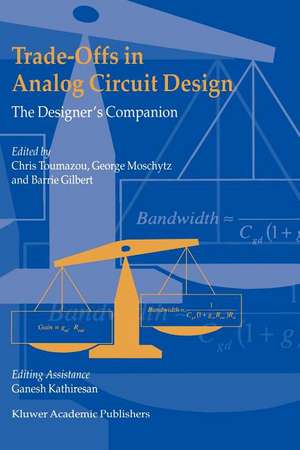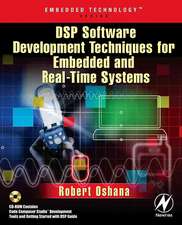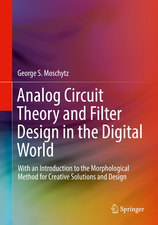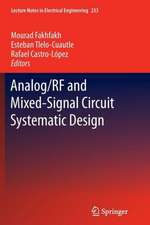Trade-Offs in Analog Circuit Design: The Designer's Companion
Editat de Chris Toumazou, George S. Moschytz, Barrie Gilberten Limba Engleză Paperback – 2 aug 2004
Trade-offs in Analog Circuit Design, which is devoted to the understanding of trade-offs in analog design, is quite unique in that it draws together fundamental material from, and identifies interrelationships within, a number of key analog circuits. The book covers ten subject areas: Design methodology, Technology, General Performance, Filters, Switched Circuits, Oscillators, Data Converters, Transceivers, Neural Processing, and Analog CAD. Within these subject areas it deals with a wide diversity of trade-offs ranging from frequency-dynamic range and power, gain-bandwidth, speed-dynamic range and phase noise, to tradeoffs in design for manufacture and IC layout. The book has by far transcended its original scope and has become both a designer's companion as well as a graduate textbook. An important feature of this book is that it promotes an intuitive approach to understanding analog circuits by explaining fundamental relationships and, in many cases, providing practical illustrative examples to demonstrate the inherent basic interrelationships and trade-offs.
Trade-offs in Analog Circuit Design draws together 34 contributions from some of the world's most eminent analog circuits-and-systems designers to provide, for the first time, a comprehensive text devoted to a very important and timely approach to analog circuit design.
| Toate formatele și edițiile | Preț | Express |
|---|---|---|
| Paperback (1) | 1255.16 lei 6-8 săpt. | |
| Springer Us – 2 aug 2004 | 1255.16 lei 6-8 săpt. | |
| Hardback (1) | 1266.05 lei 6-8 săpt. | |
| Springer Us – 29 sep 2002 | 1266.05 lei 6-8 săpt. |
Preț: 1255.16 lei
Preț vechi: 1530.68 lei
-18% Nou
Puncte Express: 1883
Preț estimativ în valută:
240.16€ • 250.78$ • 198.33£
240.16€ • 250.78$ • 198.33£
Carte tipărită la comandă
Livrare economică 15-29 aprilie
Preluare comenzi: 021 569.72.76
Specificații
ISBN-13: 9781402080463
ISBN-10: 1402080468
Pagini: 1048
Ilustrații: LXX, 1048 p.
Dimensiuni: 155 x 235 x 61 mm
Greutate: 1.52 kg
Ediția:2002
Editura: Springer Us
Colecția Springer
Locul publicării:New York, NY, United States
ISBN-10: 1402080468
Pagini: 1048
Ilustrații: LXX, 1048 p.
Dimensiuni: 155 x 235 x 61 mm
Greutate: 1.52 kg
Ediția:2002
Editura: Springer Us
Colecția Springer
Locul publicării:New York, NY, United States
Public țintă
Professional/practitionerDescriere
As the frequency of communication systems increases and the dimensions of transistors are reduced, more and more stringent performance requirements are placed on analog circuits. This is a trend that is bound to continue for the foreseeable future and while it does, understanding performance trade-offs will constitute a vital part of the analog design process. It is the insight and intuition obtained from a fundamental understanding of performance conflicts and trade-offs, that ultimately provides the designer with the basic tools necessary for effective and creative analog design.
Trade-offs in Analog Circuit Design, which is devoted to the understanding of trade-offs in analog design, is quite unique in that it draws together fundamental material from, and identifies interrelationships within, a number of key analog circuits. The book covers ten subject areas: Design methodology, Technology, General Performance, Filters, Switched Circuits, Oscillators, Data Converters, Transceivers, Neural Processing, and Analog CAD. Within these subject areas it deals with a wide diversity of trade-offs ranging from frequency-dynamic range and power, gain-bandwidth, speed-dynamic range and phase noise, to tradeoffs in design for manufacture and IC layout. The book has by far transcended its original scope and has become both a designer's companion as well as a graduate textbook. An important feature of this book is that it promotes an intuitive approach to understanding analog circuits by explaining fundamental relationships and, in many cases, providing practical illustrative examples to demonstrate the inherent basic interrelationships and trade-offs.
Trade-offs in Analog Circuit Design draws together 34 contributions from some of the world's most eminent analog circuits-and-systems designers to provide, for the first time, a comprehensive text devoted to a very important and timely approach to analog circuit design.
Trade-offs in Analog Circuit Design, which is devoted to the understanding of trade-offs in analog design, is quite unique in that it draws together fundamental material from, and identifies interrelationships within, a number of key analog circuits. The book covers ten subject areas: Design methodology, Technology, General Performance, Filters, Switched Circuits, Oscillators, Data Converters, Transceivers, Neural Processing, and Analog CAD. Within these subject areas it deals with a wide diversity of trade-offs ranging from frequency-dynamic range and power, gain-bandwidth, speed-dynamic range and phase noise, to tradeoffs in design for manufacture and IC layout. The book has by far transcended its original scope and has become both a designer's companion as well as a graduate textbook. An important feature of this book is that it promotes an intuitive approach to understanding analog circuits by explaining fundamental relationships and, in many cases, providing practical illustrative examples to demonstrate the inherent basic interrelationships and trade-offs.
Trade-offs in Analog Circuit Design draws together 34 contributions from some of the world's most eminent analog circuits-and-systems designers to provide, for the first time, a comprehensive text devoted to a very important and timely approach to analog circuit design.
Cuprins
Foreword. Design Methodology. Qualitative Reasoning; C. Toumazou. Design for Manufacture; B. Gilbert. IC Layout for Manufacture; B. Gilbert. Technology. Trade-offs in CMOS VLSI Circuits; A.V. Mezhiba, E.G. Friedman. Floating Gate Circuits And Systems; T.S. lande. Trade-offs in bandgap reference design; A. van Staveren et al. General Performance. Generalised feedback circuit analysis and tradeoffs; S.K. Burgess, J. Choma. Analog Amplifiers Architectures: Gain Bandwidth Trade-Offs; A. Burdett, C. Toumazou. Noise, Gain and Bandwith in Analog Design; R.G. Meyer. Trade-offs in frequency compensation; A. van Staveren, et al. Frequency-Dynamic Range-Power; E. Vittoz, Y. Tsividis. Filters. Trade-offs in Sensitivity, Component Tolerances and Component Spread in Active Filter Design; G. Moschytz. Trade-Offs in Continuous Time Filters; R. Fox. Insights in Log-domain filtering; E. Drakakis, A. Burdett. Switched Circuits. Trade-offs in the Design of CMOS Comparators; A. Rodríguez-Vázquez, et al. Tradeoffs in Switched Capacitor Circuits; A. Baschirotto. Compatibility of Switched Capacitor with Digital Technology; K. Leelavattananon. Switched Capacitors or Switched Current - Which Will Succeed? J. Hughes, A. Worapishet. Oscillators. Trade-Offs in Design of Integrated LC VCOs; D. Ham. Trade-Offs in Oscillator Phase Noise; A. Hajimiri. Data Convertors. Systematic design of high-performance data converters; G. Gielen, et al. Analog power modeling for data converters and filters; G. Gielen, E. Lauwers. Speed vs. Dynamic Trade-Off in Oversampling Data Converters; R. Schreier, et al.Transceivers. Power Conscious Design of Wireless Circuits and Systems; A.A. Abidi. Trade-Offs in Photoreceiver design; M. Forbes. Analog Front End Design Considerations for DSL; N.N. Tan. Trade-offs in low noise design; M.H.L. Kouwenhoven, et al. Trade-offs in CMOS Mixer Design; G. Kathiresan, C. Toumazou. A High-Performance Dynamic Logic Phase Frequency Detector; S. Li, M. Ismail. Trade-Offs in Power Amplifiers; T. Chan, et al. Neural Processing. Trade-offs in Standard and Universal CNN Cells; M. Hanggi, et al. Analogue CAD. Top-Down Design Methodology for Analog Circuits using MATLAB and Simulink; N. Chandra, G. Roberts. Techniques and applications of symbolic analysis for analog integrated circuits; G. Gielen.
Caracteristici
Promotes an intuitive approach to understanding analog circuits by explaining fundamental relationships and, in many cases, providing practical illustrative examples to demonstrate the inherent basic interrelationships and trade-offs
Draws together 34 contributions from some of the world’s most eminent analog circuits-and-systems designers to provide, for the first time, a comprehensive text devoted to a very important and timely approach to analog circuit design
Draws together 34 contributions from some of the world’s most eminent analog circuits-and-systems designers to provide, for the first time, a comprehensive text devoted to a very important and timely approach to analog circuit design



























